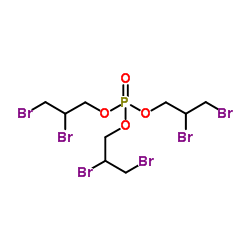Tris(2,3-dibromopropyl) phosphate

Tris(2,3-dibromopropyl) phosphate structure
|
Common Name | Tris(2,3-dibromopropyl) phosphate | ||
|---|---|---|---|---|
| CAS Number | 126-72-7 | Molecular Weight | 697.611 | |
| Density | 2.3±0.1 g/cm3 | Boiling Point | 544.2±50.0 °C at 760 mmHg | |
| Molecular Formula | C9H15Br6O4P | Melting Point | 5ºC | |
| MSDS | Chinese USA | Flash Point | 282.9±30.1 °C | |
| Symbol |



GHS07, GHS08, GHS09 |
Signal Word | Danger | |
| Name | tris(2,3-dibromopropyl) phosphate |
|---|---|
| Synonym | More Synonyms |
| Density | 2.3±0.1 g/cm3 |
|---|---|
| Boiling Point | 544.2±50.0 °C at 760 mmHg |
| Melting Point | 5ºC |
| Molecular Formula | C9H15Br6O4P |
| Molecular Weight | 697.611 |
| Flash Point | 282.9±30.1 °C |
| Exact Mass | 691.580750 |
| PSA | 54.57000 |
| LogP | 3.71 |
| Vapour Pressure | 0.0±1.4 mmHg at 25°C |
| Index of Refraction | 1.595 |
CHEMICAL IDENTIFICATION
HEALTH HAZARD DATAACUTE TOXICITY DATA
MUTATION DATA
|
| Symbol |



GHS07, GHS08, GHS09 |
|---|---|
| Signal Word | Danger |
| Hazard Statements | H302-H315-H350-H400 |
| Precautionary Statements | P201-P273-P308 + P313 |
| Personal Protective Equipment | Eyeshields;Faceshields;full-face respirator (US);Gloves;multi-purpose combination respirator cartridge (US);type ABEK (EN14387) respirator filter |
| Hazard Codes | T: Toxic;N: Dangerous for the environment; |
| Risk Phrases | R45 |
| Safety Phrases | S53-S26-S37-S61 |
| RIDADR | UN 3082 9/PG 3 |
| RTECS | UB0350000 |
| HS Code | 2919100000 |
| HS Code | 2919100000 |
|---|---|
| Summary | 2919100000 tris(2,3-dibromopropyl) phosphate。supervision conditions:89(articles on the list of prohibited export goods,articles on the list of prohibited import goods)。VAT:17.0%。tax rebate rate:9.0%。MFN tarrif:6.5%。general tariff:30.0% |
|
Haloalkylphosphorus hydrolases purified from Sphingomonas sp. strain TDK1 and Sphingobium sp. strain TCM1.
Appl. Environ. Microbiol. 80(18) , 5866-73, (2014) Phosphotriesterases catalyze the first step of organophosphorus triester degradation. The bacterial phosphotriesterases purified and characterized to date hydrolyze mainly aryl dialkyl phosphates, suc... |
|
|
Spatial distribution and inter-year variation of hexabromocyclododecane (HBCD) and tris-(2,3-dibromopropyl) isocyanurate (TBC) in farm soils at a peri-urban region.
Chemosphere 90(2) , 182-7, (2013) Hexabromocyclododecane (HBCD) is a high production volume brominated flame retardant (BFR) which has been of increasing environmental and public health concern due to its potential environmental persi... |
|
|
Use of log-linear analysis to construct explanatory models for TDBP- and AFB1-induced mutation spectra in lacI transgenic animals.
Mutat. Res. 425(1) , 55-69, (1999) Mutation spectra recovered from lacI transgenic animals exposed in separate experiments to tris-(2,3-dibromopropyl)phosphate (TDBP) or aflatoxin B1 (AFB1) were examined using log-linear analysis. Log-... |
| Phosphoric acid tris(2,3-dibromo propyl) ester |
| Tris(2,3-dibromopropyl) phosphate |
| Tris-BP |
| Zetofex ZN |
| Firemaster T23P |
| 2,3-dibromo-1-propanol phosphate (3:1) |
| Flacavon R |
| EINECS 204-799-9 |
| Anfram 3PB |
| Flam mex T 23P |
| Fyrol HB 32 |
| TDBPP |
| FireMaster T 23P |
| Flammex AP |
| Tris(2,3-dibromopropyl)phosphate |
| phosphoric acid tris-(2,3-dibromo-propyl) ester |
| Tris (flame retardant) |
| MFCD00039191 |